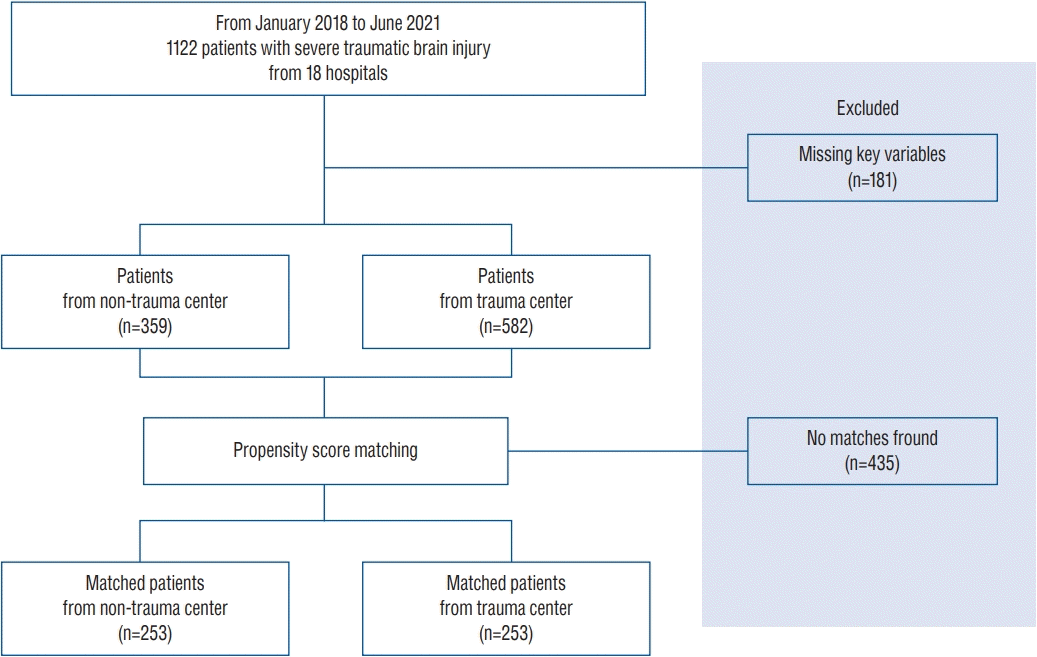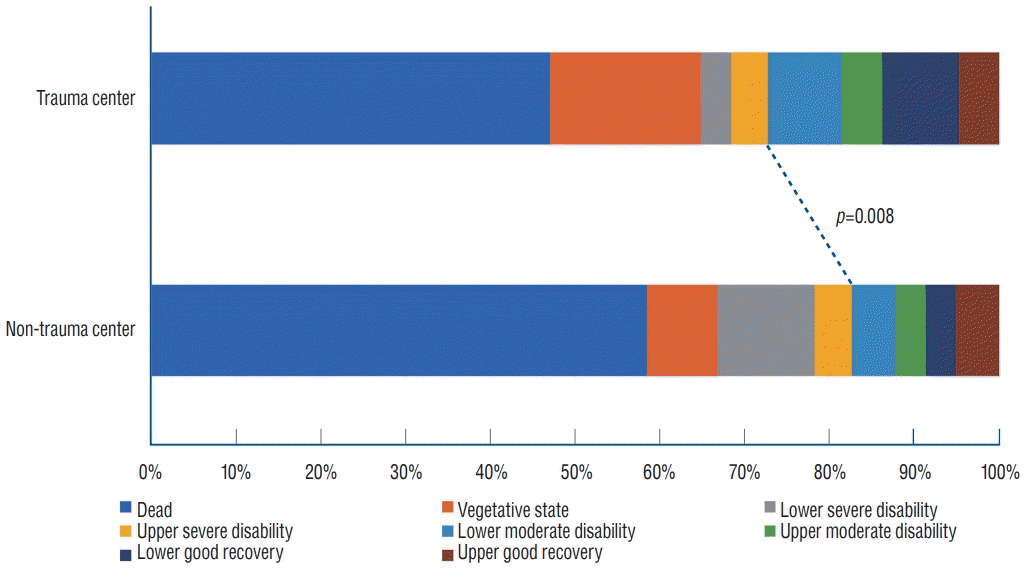1. Albanèse J, Leone M, Alliez JR, Kaya JM, Antonini F, Alliez B, et al. Decompressive craniectomy for severe traumatic brain injury: evaluation of the effects at one year. Crit Care Med. 31:2535–2538. 2003.
2. American Psychiatric Association. Diagnostic and statistical manual of mental disorders. ed 5. Arlington: American Psychiatric Association;2013.
3. ATLS Subcommittee; American College of Surgeons’ Committee on Trauma; International ATLS working group. Advanced trauma life support (ATLS®): the ninth edition. J Trauma Acute Care Surg. 74:1363–1366. 2013.
4. Carney N, Totten AM, O'Reilly C, Ullman JS, Hawryluk GW, Bell MJ, et al. Guidelines for the management of severe traumatic brain injury, fourth edition. Neurosurgery. 80:6–15. 2017.
5. DuBose JJ, Browder T, Inaba K, Teixeira PG, Chan LS, Demetriades D. Effect of trauma center designation on outcome in patients with severe traumatic brain injury. Arch Surg. 143:1213–1217. discussion 1217. 2008.
6. Eom KS. Epidemiology and outcomes of traumatic brain injury in elderly population : a multicenter analysis using Korean Neuro-Trauma Data Bank System 2010-2014. J Korean Neurosurg Soc. 62:243–255. 2019.
7. Finfer SR, Cohen J. Severe traumatic brain injury. Resuscitation. 48:77–90. 2001.
8. Han SS, Jung K, Kwon J, Kim J, Choi SC, Lee KJ. Problems with transferring major trauma patients to emergency medical center of a university hospital from another medical center. J Trauma Inj. 24:118–124. 2011.
9. Hesdorffer DC, Ghajar J. Marked improvement in adherence to traumatic brain injury guidelines in United States trauma centers. J Trauma. 63:841–847. discussion 847-848. 2007.
10. Jeong HW, Choi SW, Youm JY, Lim JW, Kwon HJ, Song SH. Mortality and epidemiology in 256 cases of pediatric traumatic brain injury: Korean Neuro-Trauma Data Bank System (KNTDBS) 2010-2014. J Korean Neurosurg Soc. 60:710–716. 2017.
11. Jung K, Kim I, Park SK, Cho H, Park CY, Yun JH, et al. Preventable trauma death rate after establishing a national trauma system in Korea. J Korean Med Sci. 34:e65. 2019.
12. Kaufman EJ, Ertefaie A, Small DS, Holena DN, Delgado MK. Comparative effectiveness of initial treatment at trauma center vs neurosurgerycapable non-trauma center for severe, isolated head injury. J Am Coll Surg. 226:741–751.e2. 2018.
13. Kirkman MA, Smith M. Multimodality neuromonitoring. Anesthesiol Clin. 34:511–523. 2016.
14. Maas AI, Hukkelhoven CW, Marshall LF, Steyerberg EW. Prediction of outcome in traumatic brain injury with computed tomographic characteristics: a comparison between the computed tomographic classification and combinations of computed tomographic predictors. Neurosurgery. 57:1173–1182. discussion 1173-1182. 2005.
15. Makarenko S, Griesdale DE, Gooderham P, Sekhon MS. Multimodal neuromonitoring for traumatic brain injury: a shift towards individualized therapy. J Clin Neurosci. 26:8–13. 2016.
16. Marshall LF. Head injury: recent past, present, and future. Neurosurgery. 47:546–561. 2000.
17. Park CY, Yu B, Kim HH, Hwang JJ, Lee J, Cho HM, et al. PARK index for preventable major trauma death rate. J Trauma Inj. 28:115–122. 2015.
18. Park JH, Park JE, Kim SH, Lim YC, You NK, Ahn YH, et al. Outcomes of ultra-early decompressive craniectomy after severe traumatic brain injury-treatment outcomes after severe TBI. Korean J Neurotrauma. 10:112–118. 2014.
19. Park JM. Outcomes of the support services for the establishment of regional level 1 trauma centers. J Korean Med Assoc. 59:923–930. 2016.
20. Rosenfeld JV, Maas AI, Bragge P, Morganti-Kossmann MC, Manley GT, Gruen RL. Early management of severe traumatic brain injury. Lancet. 380:1088–1098. 2012.
21. Shukla D, Devi BI, Agrawal A. Outcome measures for traumatic brain injury. Clin Neurol Neurosurg. 113:435–441. 2011.
22. Smith M. Multimodality neuromonitoring in adult traumatic brain injury: a narrative review. Anesthesiology. 128:401–415. 2018.
23. Song SY, Lee SK, Eom KS; KNTDB Investigators. Analysis of mortality and epidemiology in 2617 cases of traumatic brain injury : Korean Neuro-Trauma Data Bank System 2010-2014. J Korean Neurosurg Soc. 59:485–491. 2016.
24. Ucar T, Akyuz M, Kazan S, Tuncer R. Role of decompressive surgery in the management of severe head injuries: prognostic factors and patient selection. J Neurotrauma. 22:1311–1318. 2005.
25. Wilberger JE Jr, Harris M, Diamond DL. Acute subdural hematoma: morbidity, mortality, and operative timing. J Neurosurg. 74:212–218. 1991.




 PDF
PDF Citation
Citation Print
Print





 XML Download
XML Download